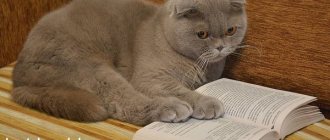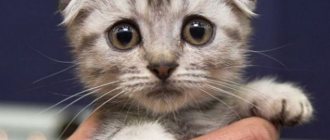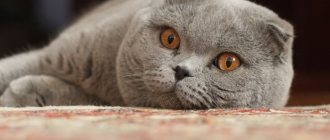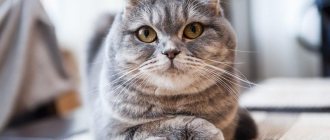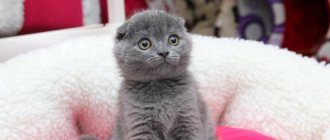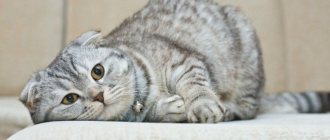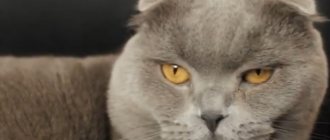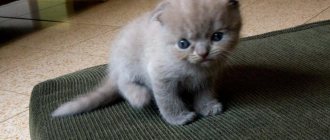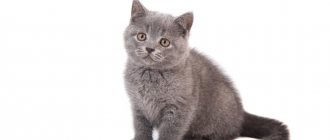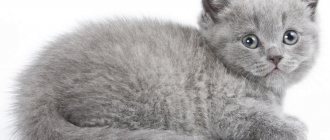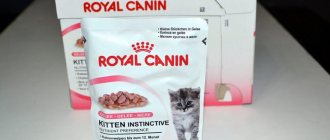The peculiarity of the Scottish Fold cat lies in the shape of its ears, which is not characteristic of other cats; it was once considered a defect, greatly transformed the animal and became the impetus for the creation of a new breed. It was formed with the participation of British and American Shorthair cats.
Not all world organizations enthusiastically accepted the breed with such non-standard ears. Only the CFA and WCF recognized Scottish Fold cats as a test breed in 1974, and four years later, at an elite exhibition in the USA, animals of this breed were met with rave reviews from felinologists and ordinary spectators. Since then, these charming cats began to fully participate in various types of exhibitions.
Breed varieties:
- Scottish Straights have a short coat and straight ears;
- Scottish Fold - short-haired with drooping ears;
- Highland Folds have long fur and ears close to the head.
- Highland Straights are long-haired with straight ears.
In addition to their unusual appearance, Scottish cats also have behavioral characteristics. They love to stand in a column on their hind legs. This is done not to attract attention or to see something better, but to warm up the spine. Another feature is their fear of heights, so they definitely won’t climb on cabinets or hang on curtains; these cats choose more aristocratic methods for their entertainment.
[advertising]
Description of breed standards:
- the body is of medium size, well-developed muscles, the maximum weight of a female is 4-5 kg, a male is 8-10 kg;
- the neck is short and strong;
- the legs are massive, the paws are oval-shaped;
- the tail is short and wide, tapering towards the tip;
- the head is spherical in shape with large plump cheeks, a massive chin and a flattened, humped nose;
- the ears are small, adjacent to the head, rounded at the ends;
- the eyes are large and set wide apart;
- The fur is thick and plush.
Kittens are born with straight ears. Only when they reach the age of 4-5 months can they change their shape and lie on their heads. The shape of their pressing to the head can also be different. Single, double or even triple folding of the ears stands out. The most valuable and expensive of all is the Scottish Fold cat, which has a triple fold of ears that fit snugly to the head, following its contour. Kittens whose ears have not drooped by the time they reach a certain age remain with straight ears for the rest of their lives. The pattern of this process has not yet been clarified, so the number of Scottish Folds in a litter is unpredictable.
British tabby cat and its colors
British tabbies are animals that can boast of brightness and originality due to the unusual pattern formed on their fur.
It is genetically determined that the pets of the presented breed must necessarily display a characteristic pattern after birth. However, sometimes the agouti factor prevents the pattern from appearing; in this case, babies are born with a monochromatic coat. Only some kittens have intricate stripes, spots, or in certain areas the fur is less or more saturated. True, with age this all disappears and adult British cats become monochromatic.
In order for an animal to be accepted for exhibition, it must have clear tabby patterns. Otherwise, the pet will be considered “defective”. This will not take away beauty, but the “doors to society” will be closed.
Diseases of the breed
The life expectancy of Scottish Fold cats is from 10 to 15 years. In order for your animal to live a long and healthy life, it is necessary to visit a veterinarian promptly, receive appropriate vaccinations, have joints checked, and follow the veterinarian's advice. The breed has some underlying health problems.
Hypertrophic cardiomyopathy
Hypertrophic cardiomyopathy is a hereditary heart disease. Symptoms:
- tachycardia;
- dyspnea;
- heavy breathing with wheezing;
- pulmonary edema;
- fainting;
- failure of the pelvic limb; in rare cases, both limbs may fail;
- high blood pressure.
The disease is diagnosed by measuring blood pressure at a veterinarian, undergoing echocardiography (data on the functionality of the heart is revealed), visual assessment, x-ray diagnostics, and electrocardiography. Animals in serious condition should be treated only in a hospital hospital, where there are all conditions for such cats. A veterinarian examines the animal’s condition and prescribes treatment, light physical activity and a special diet. If the animal feels better, it can be treated at home, unquestioningly following all the instructions of the treating veterinarian. The problem can be cured, but such cats will always have to be checked by veterinary cardiologists.
Degenerative joint disease
This disease is characterized by the fact that pain is present in the tail (most often) and the mobility of the limbs is reduced. Symptoms:
- obvious lameness;
- the cat’s reluctance to jump on chairs or sofas;
- it is difficult for a cat to get up from the floor after resting;
- frequent and prolonged licking of joints when washing;
- the cat becomes irritable and may hiss, scratch or bite.
The disease is treated with anti-inflammatory non-steroidal drugs; if the disease is advanced, antibiotics are prescribed. Additionally, a diet may be prescribed.
Osteochondrodysplasia
It is expressed in deformation of the paws, skeleton, and immobility of the tail. Symptoms:
- lameness (may pass and reappear, and an animal with illness will not be able to jump on high ground);
- squat appearance;
- stiff gait;
- acute reaction to touching the tail;
- severe deformation of the hind limbs;
- unsteady gait.
Treatment is aimed at eliminating symptoms with medication. In the absence of polycystic kidney disease, a non-steroidal anti-inflammatory drug can be prescribed; it will relieve the cat of pain and reduce inflammation. Additionally, vitamin complexes and special supplements are prescribed. In the UK, such sick cats undergo irradiation of their extremities; for a long time the cat can calmly walk, run and jump. In Russia there are no such technologies, so such operations are not carried out.
The disease often occurs when two fold-eared cats are crossed. From such parents there will be sick offspring with problems with the musculoskeletal system and skeletal structure.
British tabby color standard
Tabby color has a certain standard. And even if the pattern is as close as possible to the acceptable one, but is not, then the animal is no longer listed.
- a light spot located behind the ear;
- pattern in the form of the letter “M” on the forehead;
- eyeliner;
- contrasting pattern;
- "necklace" on the chest.
Thanks to the peculiarities of the designs, it seems that there are intricate rings on the paws, which also frame the tail. At the same time, faint but striking stripes can be seen on the stomach and chest. A prerequisite is that the rim of the nose and eyes be the same color. Breeders note that the brighter and more saturated the pattern, the more elite and expensive the animal.
Varieties of British tabby pattern
Tabby is not one specific pattern, as many people think. It can have several varieties, which are the norm.
- marble;
- leopard or spotted;
- mackerel - tiger or striped.
All these shades are considered standards.
Tiger pattern
The brindle tabby is one of the most popular species found today. The main color runs along the vertebra. You should pay attention to the clarity and density of the marks. If they are streaky or unclear, then you can doubt the shade. There are thin lines on the tails and paws that resemble rings. Tiger representatives have a colored letter “M” on their forehead.
Spotted
Spotted representatives must have dark round spots scattered throughout the coat. The line on a vertebra is never continuous. Some of the most beautiful are considered to be those Britons who have colored rings on their tails, stripes on their paws, and multiple round spots on their tummy and back. Some breeders call such animals leopards because their colors are as close as possible to these felines.
Brown tabby
Brown tabbies boast a dark coat color with a copper tint. The picture is as bright as possible – black, close to charcoal. Such Britons must have a red-brown nose liner. The pets shown are rare, although they can be found in some regions.
Lilac tabby
The amazing beauty of purple tabbies fascinates everyone who has ever seen them. The main color of the animals is beige. As for lilac, this is the shade of markings all over the fur of pets. The peculiarity of this species is the pink nose and pink pads, which look incredibly gentle against the general background.
Abyssinian specimen
This subspecies got its name in honor of the Abyssinian cat breed. The fact is that the British of this variety do not have a pattern on their coat. At the same time, it seems that they were decorated in a checkerboard pattern. This is possible due to the main black color and lightened hairs, which can be cream, apricot and sand.
The color differs in that there is a main color and a background. In this case, there should be no spots, stripes or patterns. Sometimes several colors alternate on the hairs. Sometimes there is lightening on the tummy, and a necklace on the neck - and that’s all that the standard is limited to. The Abyssinian does not allow anything unnecessary, because otherwise the animal cannot be classified as this British breed.
Marble
Marbled tabbies are considered one of the brightest and most beautiful. These animals have such complex colors that they are rare. We are talking about circles on the hips and sides, as well as several parallel lines running along the vertebra. In addition, a long line begins from the corners of the eyes, passing through the cheeks, and then going to the back of the head. Due to this, the animals look incredibly charming and bright. The presented color is also called marble on silver.
Blue tabby
The presented color is one of the most interesting. This happens because the blue pattern is dominant. The main color is rich but light. At the same time, spots of a dark blue hue can be observed on the tail and throughout the body. The nose and paw pads look unusual because they can be pink or blue.
Breeding and care
The Scottish Fold cat is unpretentious and does not require special care. Twice a month it is necessary to inspect and clean her ears. Healthy ears inside should be free of plaque and unpleasant odor. When eyes become dirty, they should be cleaned with a damp cotton pad. Representatives of the breed love to use scratching posts and do not damage furniture or wallpaper, which is their significant advantage. If the claws grow too long, they need to be trimmed.
You need to bathe your cat once every 1-2 months. The fur must be combed periodically to prevent tangles from forming. This must be done first in the direction of growth, and then against it. This procedure gives the pet great pleasure.
The diet of these cats should consist of premium dry and important foods and natural products: breast, beef, fish, offal, cereals, eggs, dairy products and fiber. It is forbidden to feed fatty, fried, sweet and salty foods.
The disadvantages of these cats include weak bones and fragile health. But if you take proper care, they can be avoided. Representatives of this breed can live up to 20 years.
To get good offspring, it is important to follow the following rules:
- A Scottish Fold cat should only be mated with a straight-eared cat of the same breed. If the cat has straight ears, then it should be bred with a fold-eared cat.
- It is better to choose a male of a uniform color for mating, as they are most in demand.
- If a female of this breed becomes pregnant, then to avoid complications it is better to squeeze her less and protect her from stress and small children.
Solid (solid, plain)
A solid color implies the absence of any slightest admixture of other shades. The surface of the fur is colored evenly on all parts of the body. The Scots once upon a time considered gray or blue to be the most common color. These are the favorites most often found among breeders. But today seals with other colors are also gaining more and more popularity: white, chocolate, black, brown, cream, red and fawn (which literally means the color of a young deer). Sometimes it happens that nature interferes with the uniform color of the fur and leaves a mark of a different color there. Such cats noticeably lose value because they are considered a breed defect.
With white
In the color of the Scots, white may be present in parallel with another shade. Depending on the “amount” of white on the animal’s body, several varieties of colors of these cats are distinguished.
Bicolor
Bicolor (two-color) implies from 30 to 70% white in the color of a cat. An additional shade may include:
- blue;
- cream;
- red;
- tabi.
As a rule, the paws, belly, neck, part of the muzzle and chest are white.
Harlequin
The originality of the harlequin's color lies in the white coloring of 4/5 parts of the animal's body. The tail, top of the head and ears should be black. The tip of the cat's nose is pink.
Vannes
The bath variety involves the presence of colored spots on the head (sometimes) and a colored tail.
Point (point)
The more common name for this color is color point. It is characterized by the fact that the main color of the animal turns into a darker color at the tip of the muzzle, tail, ears and paws. This is due to the fact that in the blood of such animals there is a special gene that affects the darkening of the hair in those parts of the body where the temperature is low.
There are several variations of this color, which are shown in the table below, there may be others:
| Color name, photo | Main color | Additional color |
| Seal Point | Light beige | Brown |
| Lilac Point | White | Lilac |
| Blue Point | Pale blue | Dark blue |
| Chalklit Point | White | Brown |
| Cream-point Cream-blue-point | Pale cream | Cream |
| Red point | Pale cream | Ginger |
| Tabby (lynx) point | Any | Stripes to match the main color |
| Torty point | Tortoiseshell | Red or cream spots on the base coat color |
Genetics and origin history
The tabby coloring is influenced by genetics, namely the “A” gene. He belongs to the super dominant group. He dyes his mustachioed friend's fur in a special way, alternating different tones.
Due to the dark pigment, some areas are more clearly defined. On light areas of the coat, the effect of alternation creates less contrast, which looks original and beautiful. A striking example of this is the Asian red tabby.
Initially, all kittens develop a color according to their genotype, then the “childish” color disappears and their characteristic color appears.
Studies have shown that the spots and stripes on the pets are similar in appearance to the Asian, African and European wild cats.
Torti (turtle)
It should be noted right away that you can only buy a turtle girl. In males, this color is not provided by genetics. But if you do come across a cat like this, then this is a big exception, which, however, does not increase its cost, but, on the contrary, reduces it.
Tortoiseshell color is considered to be fur on which spots of different colors (black, chocolate, blue, lilac) alternate with red or cream marks. For breeders, a particularly important indicator is the intensity of pigment expression and uniformity of location.
Smoky (smoky, smoky)
The main condition for this color is that the hairs at the base of the body must have a silver-white tint. Those. the silvery-white hair turns into another color, such as black or blue. This phenomenon is called typing and occurs as a result of a dominant silver gene. The smoke can be different, for example, chocolate.
There are often cats with additional patterns on their fur, but according to color rules this should not be the case.
Don't confuse this color with a solid color! If you're not sure, part your cat's fur and see what color is at the base of his fur.
Pros and cons of the breed
The “loop eared” gene immediately gives rise to several pros and cons that need to be taken into account when deciding to take a pet home.
Advantages of the breed:
- unique appearance , since the breed has a pronounced appearance;
- cute facial expression with a rounded face and flattened ears;
- funny behavior: due to the structural features of the skeleton, pets love to sit in the “Buddha” pose;
- sociability , as pets love to play and interact with people;
- obedience , that is, a kitten can easily be accustomed to the rules of behavior in the house;
- variety of colors - cats do not have a “standard” skin color, although gray shades with a bluish tint are most common;
- longevity , as pets live 15-20 years;
- cleanliness , because cats diligently lick themselves and do not like to get their fur dirty;
- a unique raspy voice that doesn't sound like a normal purr.
Disadvantages of the breed:
- cats are prone to overeating and, as a result, become overweight;
- there are restrictions on crossing. You cannot mate cats and cats if they both have lop ears;
- there may be problems with the skeleton, heart, kidneys;
- If you are sick, you should always contact an experienced veterinarian who understands the characteristics of the Scottish Fold breed.
Important! All deficiencies appear only if there are genetic abnormalities or if maintenance standards are violated.
Tabby (tabby)
Such cats have stripes of an unusual shape and a different color than the main color. The most common marks are on the forehead, for example, in the shape of the letter M, light spots on the back of the ears, a necklace on the chest, rings on the paws and tail, curls on the cheeks, eyes outlined as if with shadows.
Breeders distinguish several variants of tabby. According to the type of pattern, they are marbled (shaded), tiger (mackerel) and spotted (spotted).
There is a complex classification of Scots tabby dogs based on combined colors and shades. They are presented in the table below:
| Name | Main color | Pattern color |
| Silver | Silver | Black |
| Silver blue | Light blue, white undercoat | Mantle on muzzle, tail and sides |
| Red | Light red | Bright red |
| Brown | Copper | Black |
| Blue | Cream blue | Bright blue |
| Cream | Pale cream | Beige or dark cream |
| Cameo | White | Bright red |
Types of colors
Scottish Fold or Scottish Fold, a small animal weighing about 6 kg. The main feature is the presence of small ears, tilted forward and covering the auricles. Another characteristic feature is large, widely spaced eyes, very expressive. These cats meow strangely and creakingly. The breed was bred in the 60s of the last century.
To read: Kishu breed from the land of the rising sun: how to get along with your pet
Scottishfolds are characterized by both short plush and semi-long coats. Kittens will be born with straight ears. After a certain time, some kittens' ears become bent. The rest fall into the Scottish Strike category. The Scots have a strong, rounded torso. Short neck. The legs are of medium length, the tail is above average length. The colors of the eyes are very diverse - yellow, green, blue, brown, orange, gold. The nose is short and wide, with large whisker pads. There is a significant variety of colors of this breed.
White
All Scottish Folds are descended from white cats. They can have almost any coloring of their eyes, they even have different eyes - one eye is dark orange, the other is light blue. In white kittens up to one and a half years old, blue or black fur is acceptable on the head; after molting, it disappears.
White kittens are sometimes born deaf. When purchasing, it is worth checking by clapping your hands.
Cream
Very elegant color with a faint peach touch. Small leopard spots sometimes appear during molting. Eye coloring is dark orange or orange.
Black
In black Scots, no light inclusions are allowed. Only concentrated and deep color. Eye color is dark orange.
A cat's eyes are larger in relation to body size than those of most mammals.
Cinnamon color
The coloring is rare, so kittens are expensive. Various color gradations are allowed. The paw pads are brown and pink, the nose lobe is the same.
Brown (chocolate)
Any gradation of brown tones is allowed. Residual patterns after molting are not recognized. This color is considered unique. The nose and paw pads are light brown.
Lilac
The fur is beige. The eyes should be dark orange or orange in color.
Cats can see up to 60 meters away. Field of view is about 185, peripheral up to 285 degrees.
Red color
The uniqueness of the color of the animal depends on the color scheme and the clarity of the shades. In red Scottishfolds, the base of the hairs is light and gradually darkens towards the end. The tip is red.
Blue
Scottishfold blue has a wide variety of shades. From the lightest to the darkest, from light blue to blue. A solid color is required.
Bicolor
The coloring of bicolor cats allows two colors, one of which is white in combination with any other. The color distribution is approximately 30/70%. The classic bicolor, which is most valued, has the ideal of white paws, chest, neck and chin, and part of the muzzle. There is a kind of open necklace on the chest and neck. A small white triangle with a point on the forehead. The most common and beautiful bicolors are CREAM, BLUE and BLACK.
Point or Whiskas
A distinctive feature of this color is the light fur, like a background. She has darker shades in certain areas of her body. On the paws, ears, muzzle and tail area. The main thing here is the contrast of colors; extraneous patterns are not allowed, in particular on the stomach. The kittens are born light, but as they grow older the color becomes more pronounced. Only after a long period of time, up to 2 years, is the final coloration of the cat established.
To read: Graceful Asian Burmese cat (Burmese): origin and character
Lilac (lilac)
Color code c33. The color of the body is slightly different from light, there is a slight purple coating, the spots of markings are gray with pink, dark but warm in tone. Bright blue eye color. The paw pads and nose pads are pink and gray.
The surface pattern of a cat's nose is unique, just like a person's fingerprints.
Blue
The standard color of this cat is “Siamese”, since Siamese cats have this coloring. Color code a33.
Cream
Color code e33. Light body, almost white. A color deposit under baked milk is allowed. The markings are cream, the eyes are light blue or dark blue. A small surviving drawing may be visible. Paw pads and nose pads are beige. If they are not very contrasting, then the eyes should simply shine.
A kitten's eye color may change over time.
Cream blue
The difference lies in the background fur. These are different variations of baked milk.
Chok-lit (chocolate)
Color code b33. Chocolate colored spots on the body. The body is beige.
Red
Color code d33. Unusual red color with warm tint marks. The body is white with a slight touch of gold or a faint orange, reddish tint. The paw and nose pads are pink and beige.
Strength
Dark brown patches of markings on a light cream body. The pads on the paws and nose are chocolate.
Torti
The main thing in coloring is that the markings of the spots repeat one of the main colors, spots of red or cream color.
- SIL CAKE (f33)
- BLUE CREAM CAKE (g33)
- CHAKLI CAKE (h33)
- LILAC CAKE (j33)
- CINNAMON CAKE (q33)
- FAUN CAKE (r33)
Tortoiseshells
Due to genetic characteristics, tortoiseshell colors are found exclusively in cats. This color is a combination of finely spotted coloring in equally distributed colors of red and black cells. The color should look proportional. The colors of the two cells should be evenly distributed. Brindle spots are prohibited. Eye color is dark orange or gold. Paw pads and nose pads are black, pink or black and pink. Recognized tortoiseshell colors include:
- BLACK-RED (SFSf)
- CHOCOLATE RED (SFSh)
- BLUE-CREAM (SFSg)
- LILOW-CREAM (SFSj)
- CINNAMON-RED (SFSq)
- FAUN-CREAM (SFSr)
Also, depending on the haze, a second letter is added - s.
- TORBILE - tortoiseshell tabby (tiger color). This is f22,23,24. Spot, stripe or marble.
- TORTI – tortoiseshell color point.
Black (ns)
A rare, special color, so it is in demand. The essence of color: white undercoat. When the cat moves, a light color appears. That's very beautiful. As a rule, the hairs on the sides are lighter and slightly silvery. There should be no extraneous inclusions or drawings. The paw pads and nose pads are black. Dark orange or orange eye color.
Chocolate
Compared to the classic brown color scheme, the color here looks lighter. “Silver” appears on the sides and on the ears. The paw pads and nose are chestnut.
To read: How to give an original name to a Yorkshire Terrier dog: nicknames for girls and boys
Blue smoke
Very strict requirements for this color. All shades of blue are allowed. The undercoat is white, no residual patterns.
Tabby
This is the most contrasting and brightest color of the Scottishfold. The color of the coat can be varied, and the pattern is only spotted, brindle or marbled. There is also a ticked color - similar in appearance to a single color, but striped hairs appear on the back, and in the forehead area there is a characteristic “M”.
Spotted
The letter “M” in the forehead area, a necklace, circular stripes on the paws and tail, spots on the belly. The stripes are not continuous, but torn throughout the entire body area. Leopard coloring book.
Striped
It looks like a spotted one, but the stripes are clear, not broken, and contrasting. If the stripes widen or are interrupted with age, the color is no longer considered brindle. Eye color – orange, dark orange, green.
Marble
Two lines stretch longitudinally from head to tail. There are closed circles on the sides. Spots similar in description to butterflies on the back of the head. The letter “M” in the forehead area, rings in the form of closed lines-stripes on the neck. The merle color is present in kittens from birth.
Particolor (calico)
Unique coloring - tortoiseshell coloring on a light background.
Shaded (shaded)
An individual color feature is a white undercoat. The upper part of the hair is shaded with a dark color. Light color exclusively on the belly and sides. There should be no surviving drawings. Possible rings on the paws and the letter “M” in the forehead area. The main shaded colors are silver, gold and red.
Wang
This is a rather rare color. The main color of the fur is white. There are spots on the face and tail. Uneven stains and multiple stains on the body are acceptable.
Harlequin
Among the Scots this color is considered rare. The main white color has large spots, the tail is colored.
Shedded (shaded)
With this type of color, two-thirds of the hair starting from the base is white, and the remaining part can be red, silver or gold. On the chin, belly and lower surface of the tail the color is light. The shaded color does not allow spots or stripes except those located on the forehead or paws.
Representatives of the Scottish breed with a similar color have white coat color as the main color, and the tail and muzzle are decorated with a different color or a combination of both (torti). There may also be spots on the body and paws.
Colorful
Colored or color-point are colors in which the main body color is light (white or cream), and the ears, muzzle, tail and paws have a darker shade. The Scots owe this rare color to their British ancestors, who had Persian cats in their family.
The rarest colors of Scottish cats
Several years ago, the highest price was set for kittens of unusual silver and gold shades. But in the modern cat market there are more and more of them. Today, ticked Scots and golden chinchillas are considered the most expensive.
Scottish straight golden chinchilla
Interesting! The most common iris color among Scots is gold. However, there are some exceptions. Usually the eye color matches the coat. Blue or multi-colored eyes are quite rare, these animals can be white, bicolor or tortie. Orange iris is a very beautiful, but the rarest eye color in this breed.
Eye colors
Scots eye color varies depending on the color variety:
- most Scottish cats have orange (orange) eyes;
- blue eyes are found in color-point and white animals;
- green – typical for golden, silver, smoky colors.
It is quite difficult to determine the type of color of a pet by eye. For this purpose, felinologists use a special color chart for Scottish cats. This makes it much easier to identify rare species. In addition, with the help of this tool you can determine by color the “correctness” of the upcoming mating of animals.
Genetics of Scottish cat colors
In cats of this breed, 2 genes predominate, which are responsible for the red and black color. One of them acts as dominant, and the other as recessive (i.e., the one that is suppressed). There is also a 3 diluent gene, which is responsible for the saturation of the pigment. These genes are combined and as a result we get a variety of colors: from the well-known blue to the cheerful-looking harlequin.
By the way, while the kitten is still small (several weeks), it is impossible to say exactly what its color will be. The final coloring is formed when, after a child's molt, the coat is replaced by an adult coat. Usually the color is ready by six months, although it may change slightly for another 1.5 years.
Cat health
Scottish Folds have several diseases that are inherited:
- Osteochondrodysplasia is a violation of the natural position of bones due to dystrophic and atrophic processes in cartilage tissue. The disease manifests itself as lameness, unsteady gait, immobility, and joint inflammation. It is more often observed on the tail, which is why it hardens. In later stages, the paws become bent. For treatment, drugs are used that stimulate the development of cartilage tissue.
- Osteoarthritis is inflammation of the joints due to the destruction and permanent injury of articular cartilage. The disease can be suspected by lameness, unsteady gait, inability to jump or jump from a height, pain on palpation of the joints. First of all, arthrosis, which is the cause of the pathology, is treated. To do this, use agents that stimulate the development of cartilage tissue.
Important! In both cases, the diagnosis is made only after an X-ray examination.
- Hypertrophic cardiomyopathy is a thickening of the outer sac that surrounds the heart, causing it to be unable to function normally. Scottish Folds have a large number of genes that can lead to such a pathology. Manifested by general signs of heart failure: edema, sweating, lethargy, shortness of breath. The diagnosis is made on the basis of ECG and ultrasound. Symptomatic therapy with diuretics and beta blockers is used.
- Polycystic kidney disease is the formation of fluid-filled cysts in the kidneys, which over time can lead to kidney failure. Symptoms include general weakness, unpleasant ammonia odor from the mouth, severe thirst, vomiting and other signs of intoxication. The diagnosis is made by analyzing blood, urine, and also after an ultrasound or x-ray. Symptomatic and supportive therapy is provided, phosphorus binders and artificial erythropoietins are widely used.
Despite all this, Scottish Fold cats with proper care live quite a long time - 15-20 years.
To maintain the health of your pet, you need to be vaccinated on time. At 2-3 months, kittens are vaccinated against calcivirosis, rhinotracheitis, panleukopenia, and chlamydia. Every six months they undergo preventive deworming. In addition, you need to monitor the condition of the coat and the presence of fleas and ticks in it.
Scottish cat color charts
When purchasing a Scottish kitten with a passport from a breeder, most likely you will see markings of numbers and letters there. This is an international code used in the classification accepted among breeders. The Scottish breed includes four cats: fold-eared (Scottish Fold), straight-eared (Scottish Straight), long-haired fold-eared (Highland Fold), straight-eared long-haired (Highland Straight).
This is what the color code looks like: XXX.xx.NN.NN.NN.(NN) , where:
XXX . Abbreviated name of the breed in three capital letters: SFS - Scottish Fold, SFS 71* - Scottish Straight, SFL - Highland Fold, SFL 71* - Highland Straight.
xx . Lowercase letters indicating the main coat color (up to two):
| Letter (designation) | English name | Russian name |
| a | blue | blue |
| b | chocolate, brown, chestnut | chocolate, brown, Havana, champagne |
| c | lilac, lavender | lilac, lavender, platinum |
| d | red, flame | red |
| e | cream | cream |
| f | tortoiseshell, patch | tortoiseshell |
| g | blue-cream, blue-tortie | blue cream, blue tortoiseshell |
| h | chocolate-tortie | chocolate tortoiseshell |
| j | lilac-tortie | lilac tortoiseshell |
| n | black, ebony, seal, sable, ruddy | black, ebony, seal, sable, wild |
| o | sorrel, cinnamon, honey | sorrel, cinnamon, honey |
| p | beige fawn | yellow-brown, beige |
| q | sorrel tortie | red-brown tortoiseshell |
| r | beige fawn cake | beige tortoiseshell |
| s | silver, smoke | silver, smoky |
| w | white | white |
| y | golden | golden |
| z | unregistered | unregistered |
NN.NN.NN.(NN) - values of pairs of digits (up to 3 main and 1 auxiliary):
- Numbers from 1 to 35, which decipher the color features (harlequin, van, smoke, etc.):
| Letter (designation) | English name | Russian name |
| 01 | van | van |
| 02 | harlequin | harlequin |
| 03 | bicolour | two-color, bicolor |
| 04 | mitted/white point | with white markings (for color points) |
| 09 | little white spots | white spotting (1-2 cm) |
| 11 | shaded | shaded (1/4 of the top part of the hair is darkened) |
| 12 | tipped, shell | veiled (1/8 of the top part of the hair is darkened) |
| 21 | tabby, agouti | striping, agouti factor |
| 22 | blotched, marble | marble |
| 23 | mackerel, tiger | mackerel, tiger |
| 24 | spotted | spotted |
| 25 | ticked | ticked or Abyssinian |
| 31 | burmese | Burmese |
| 32 | tonkinese | Tonkinese |
| 33 | himalayan or siam | Himalayan, Siamese, point |
| 34 | Singapore | Singaporean |
| 35 | abyssinian | Abyssinian |
- A pair of numbers from 51 to 54 indicating the length of the tail:
| Letter (designation) | English name | Russian name |
| 51 | rumpy | taillessness |
| 52 | rumpy riser | remainder of the tail – 1-2 vertebrae |
| 53 | stumpy | bob – 7-13 cm. curled tail |
| 54 | longy | long/normal tail |
- A pair of numbers from 61 to 67 indicating eye color:
| Letter (designation) | English name | Russian name |
| 61 | blue | blue |
| 62 | yellow, golden | yellow, orange, golden |
| 63 | oddeyed | disagreement |
| 64 | green | green |
| 65 | burmese | Burmese cat eye color |
| 66 | onkinese | Tonkinese cat eye color |
| 67 | himalayan or siam | eye color of Himalayan and Siamese cats |
- A pair of numbers 71 (straight) or 73 (dropping), indicating the shape of the ears.
Conditions of detention
Scottish cats are considered one of the easiest pets to care for. They feel great both in a small apartment and in a private house. It is worth buying or making your own personal sleeping place for an animal. It is also recommended to purchase a scratching post, the length of which should correspond to the height of the Scottish cat. You should not refuse to buy a carrier to transport your pet if necessary.
The Scots are not picky when it comes to content. In order for an animal to live comfortably in a room, it must be clean and safe. This pet is extremely clean, he puts his fur in order and quickly gets used to going to the litter box.
Before bringing a small pet into your home, you need to complete the following steps.
- Remove unnecessary objects from the kitten's access area. For example, wires, breakable and sharp objects.
- Buy food and water dishes for the animal. The best option would be heavy metal or ceramic cookware.
- Place the tray and fill it with filler. Kittens should buy a container with low sides, and as they grow older, change it to a higher model.
- Prepare a place to rest - this can be a sunbed or a blanket folded several times.
- Buy food, toys, scratching post.
Grooming
Scottish cats can be shorthaired or semi-longhaired. With cats that have short hair, there is little hassle. Their fur is brushed weekly using a special mitten or a brush with natural bristles. Semi-long-haired representatives of the breed should purchase a comb that has Teflon-coated teeth. Animals should be taught to comb from a young age.
Animals kept in the house are bathed monthly. Scots usually react well to water, but they should only wash their coat if it gets dirty. For this procedure you need to buy a special shampoo for cats. When bathing your pet, you need to make sure that water does not get into his ears. After washing, the cats are dried and sent to a warm place where there is no draft.
For water procedures, preference is given to colorless and odorless shampoos that do not contain harmful chemical ingredients and allergens. Scottish cats that participate in exhibitions are bathed depending on the color of their coat. Dark animals need to be washed a week before the event, and light animals - 5 days.
Haircuts for Scottish cats are unpleasant, but common procedures. Pets are given haircuts and hairstyles for the same purpose as other animals. This procedure can be carried out only if tangles have formed, as well as after applying medications or to remove dirt.
Nail care
Domestic cats need their nails trimmed. This process is quite simple and does not cause discomfort to the animal. You need to put Scottish on your lap and, taking his paw in your hands, press on the pads. Once your pet has released its claws, they can be trimmed. In this process, the main thing is not to damage the living body of the claw. Claws should be trimmed carefully, once every 2-3 weeks.
Eye and ear hygiene
The eyes and ears of Scottish cats need regular examination. These animals usually have clean ears, but when plaque appears in them, the contamination is removed with a cotton swab. When cleaning your ears, you can also use a special lotion.
The special structure of the skull of the Scottish breed of cats causes the narrowing of their nasolacrimal ducts. For this reason, your pet may experience slight discharge from the eyes. In this case, the eyes need to be cleaned with a cotton pad or chlorhexidine wipe.
Dental care
To keep the pet's teeth in good condition, the owner can buy him a special toy - an edible chewing stick. Alternatively, you can use a toothbrush and toothpaste for cats. A Scottish cat's teeth should be brushed 1 or 2 times a week. Scottish dogs do not like this process, so it is better to accustom them to this from an early age.
Kitten care
Scottish kittens do not require special care. They can be fed dry food, but of good quality. Kittens should not be brushed unless there is a reason for it. Babies with long hair should be gradually accustomed to brushing, carrying out the procedure twice a month. Little Scottish cats need to be bathed only if they are very dirty in the mud.
Kittens need to have their nails trimmed from an early age so that they get used to this procedure. You don't need to clean your ears, but if they smell bad, that's a reason to go to the vet. Watery eyes should be wiped once every 7 days with a cotton pad soaked in chlorhexidine.
How coat color affects the character of a Scotsman
When purchasing a pet, you should not chase fashion; it is better to trust your preferences and tastes. The main thing is that the cat turns out to be “yours” in temperament and character. By the way, some cat owners are sure that the color of the fur affects the behavior of the animal and leaves an imprint on its character.
White and light colored
You want to cuddle these babies endlessly. But they, as a rule, do not like increased attention to themselves. Although they are very loyal to the owner, they are extremely wary and wary of other people. Among some peoples there is a belief that a white cat brings good luck. Whether this is true or not is not known for certain. But the white color can cause a lot of problems for the cats themselves, since 5% of all snow-white cats are born completely deaf. Previously, it was believed that deafness was the fate of absolutely all white-furred tails, but later scientists proved that this is not so. But when buying such a kitten, you should still be more careful.
Black
Despite all the existing prejudices and myths regarding black cats, in practice they are one of the friendliest towards people. They like to stay close to their owner all their free time and always keep him in sight. Charcoal cats are wise, quick-witted, and keenly aware of a person’s mood.
Redheads
Such animals are a ray of sunshine in your home. It is believed that a ginger cat in the home is the key to an indispensable increase in well-being. Those with fiery fur are very playful, willful, cheerful and curious creatures. The golden shades of fur that are fashionable today are characteristic of more formidable animals, whose disposition can hardly be called friendly. And golden Siamese cats are generally considered the worst tailed cats.
Blue and silver
Silver and blue fluffies are real aristocrats. Calm, balanced, noble. They love their owner devotedly, although they are not always ready to demonstrate this publicly. It is believed that these four-legged pets are able to calm and relieve stress in humans. In addition, cats of this color are absolutely not vindictive.
Two-color
Such cats are most in demand among buyers. In addition to their interesting color, they have an easy-going disposition, are friendly, and kind even towards children. Bicolor cats love their owners very much and get along well with other pets.
Personality of the Scottish Fold
The Scottish Fold cat, whose character is one of its significant advantages, is an animal with a kind soul, calm behavior, aristocratic manners and moderately playful. These cats love their owners very much and get along well with children and other pets. One of the distinctive features of these creatures is their taciturnity; they meow quietly and rarely.
Such cats are perfect for people who do not tolerate fuss and lead a calm, measured life. Even in childhood, kittens of this breed behave moderately and do not cause much damage to the home. But, it’s true, they can hide a variety of small objects in secluded places, for example, glasses, pencils, pens.
[advertising-text]
Scottish Fold cats are very clean and intelligent. Adults are distinguished by affectionateness, calmness and understanding. They may comply if the request suits their interests. But they also show stubbornness if they don’t like something.
Unlike their close relatives, British cats, which can completely ignore the presence of a person, Scottish Folds communicate well with people, choosing a favorite and often staying near it. But despite their devotion, these cats are not at all intrusive; they prefer to be close to a person, but not in his arms.
[advertisement1]
According to many owners, the Scottish Fold cat likes to meditate with its paws stretched forward. These cats also love to sleep on their backs and love massages that are given to them using a comb.
Thanks to its meek disposition, softness and tenderness, the Scottish cat can become a wonderful friend for many years. Many owners consider representatives of this breed to be ideal pets, who are moderately playful, do not misbehave and are easy to train. And the appearance of these animals has never left anyone indifferent.
